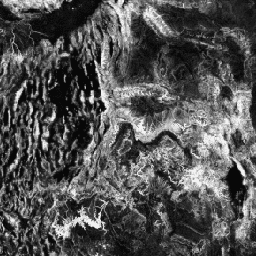
- 데이터 세트 사용 가능 기간
- 2006-01-24T00:00:00Z–2011-05-13T00:00:00Z
- 데이터 세트 제공업체
- 보존 과학 파트너
- 태그
설명
지형 다양성 (D)은 종이 지역 서식지로 이용할 수 있는 다양한 온도 및 습도 조건을 나타내는 대리 변수입니다. 이는 다양한 지형 기후 니치가 더 높은 다양성 (특히 식물)을 지원하고 기후 변화를 고려할 때 종의 지속성을 지원해야 한다는 논리를 나타냅니다.
D를 계산하기 위해 토양 수분 (T)의 지배적인 제어인 다중 스케일 지형 위치 지수 (mTPI)가 언덕 경사면 위치를 측정하는 데 사용되었습니다. mTPI는 mTPI>0 (T')의 제곱근 변환과 여러 스케일에서 계산된 연속 열-절연 부하 지수 (CHILI)의 표준 편차 (C')와 결합되었습니다. D = 1 - ((1-T') * (1-C')). JAXA의 ALOS DEM (EE에서 JAXA/ALOS/AW3D30_V1_1로 사용 가능)의 30m 'AVE' 밴드를 기반으로 합니다.
Conservation Science Partners (CSP)의 생태학적으로 관련된 지형학(ERGo) 데이터 세트, 지형 및 지형학에는 지형 및 지형학 (즉, 토지 패싯) 패턴에 관한 상세한 다중 스케일 데이터가 포함되어 있습니다. 이러한 데이터는 다양한 용도로 사용될 수 있지만, 원래 목적은 기후 적응 계획에 적합한 지형 및 지형학적 분류와 지도를 개발하는 것이었습니다. 미래 기후 조건과 생태학적 반응에 대한 불확실성이 크기 때문에 변화가 없을 가능성이 높은 요소에 관한 정보를 제공하면 관리자가 강력한 기후 적응 계획을 수립할 수 있는 강력한 기반이 됩니다. 이러한 지형의 특징은 해상도에 민감하므로 특정 지수의 범위와 특성을 고려하여 가능한 가장 높은 해상도를 제공합니다.
대역
픽셀 크기
270미터
대역
| 이름 | 최소 | 최대 | 픽셀 크기 | 설명 |
|---|---|---|---|---|
constant |
0* | 1* | 미터 | ALOS에서 파생된 지형 다양성 |
이용약관
이용약관
인용
Theobald, D. M., Harrison-Atlas, D., Monahan, W. B., & Albano, C. M. (2015). 기후 적응 계획을 위한 지형 및 지형학적 다양성의 생태학적 관련 지도입니다. PloS one, 10(12), e0143619
Earth Engine으로 탐색하기
코드 편집기(JavaScript)
var dataset = ee.Image('CSP/ERGo/1_0/Global/ALOS_topoDiversity'); var alosTopographicDiversity = dataset.select('constant'); var alosTopographicDiversityVis = { min: 0.0, max: 1.0, }; Map.setCenter(-111.313, 39.724, 6); Map.addLayer( alosTopographicDiversity, alosTopographicDiversityVis, 'ALOS Topographic Diversity');
